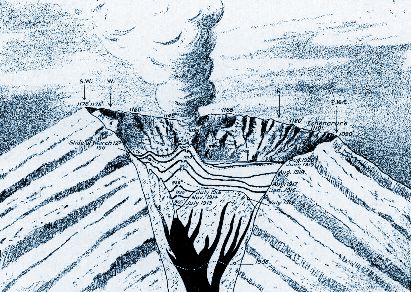






The Department of Sociology and Anthropology, in the College of Humanities and Social Sciences, and the Department of Geosciences, in the College of Science and Mathematics, co-sponsored a field course for two weeks in May, 1998, on the archaeology and geology of ancient Italy.
The course took participants on a tour of selected areas of southern Italy, including Sicily and the nearby Aeolian islands in the Mediterranean. It was a joint offering by the two departments and was cross listed as Geology 495 and Anthropology 495, for 4 credits.
The course was offered through Continuing Education at North Dakota State University and was therefore open to anyone who qualified for continuing education, whether registered student, alumnus, or interested community member.
The trip took place from May 11-25, 1998. The study tour provided an intensive introduction to Mediterranean vulcanism and geology, and to Roman and Greek prehistory in Italy. Trip leaders were Dr. Jeffrey T. Clark, Associate Professor of Anthropology, and Dr. Bernhardt Saini-Eidukat, Assistant Professor of Geosciences, both at North Dakota State University.
An outline of key stops is given below. The itinerary is available here.
We arrived in Rome and spent two nights. While there we visited a few of the classic sites of Rome (such as the Colosseum, and the Forum).
Then we headed south to Sorrento. From a spectacular base perched above the Mediterranean Sea, we visited the archaeological sites of Pompeii and Herculaneum (Ercolano), and the volcano of Mt Vesuvius, which destroyed those ancient cities in AD 79.
Check out these links to web pages about Vesuvius!
Farther down the coast we stopped at the old Greek and later Roman town of Paestum (Greek name of Poseidon), and examined the surrounding landscape.
We left Naples by overnight boat and arrived at the Sicilian city of Palermo. On Sicily we visited several archaeological sites on the west and south coasts, such as those near Agrigento. Then we headed for eastern Sicily and the volcano of Mt. Etna.
From Sicily we headed by ferry to the islands of Vulcano and Stromboli where we hiked to the summit craters - some of us at night, and others by daylight.
Here are some excellent web pages about Stromboli.If you have red-blue glasses, you can see images in stereo!
Then it is back to Rome and the flight back to Fargo!
The cost of the trip was approximately $3000. This charge included airfare (Fargo-Rome-Fargo), tuition, transportation in Italy, lodging (based on double occupancy), food, and museum/site entry fees. Only some of this sum was charged up front as a set fee (e.g., tuition, lodging, transportation), other costs was paid by the participants as we went (eg., most of the meals and the entry fees).
Costs not included were the following: laundry, tips, airport departure tax, airfare from a city other than Fargo, souvenirs, medical expenses related to the trip (inoculations, precautionary and other medicines), passport fee, film, and other costs not specifically included.
Jeffrey Clark
Department of Sociology and Anthropology
North Dakota State University
PO Box 5075, Fargo, ND, 58105
phone (701) 231-8921
email: Jeffrey.Clark@ndsu.edu
or
Bernhardt Saini-Eidukat
Department of Geosciences
North Dakota State University
Fargo, ND, 58105
phone (701) 231-8785
email: bernhardt.saini-eidukat@ndsu.edu.